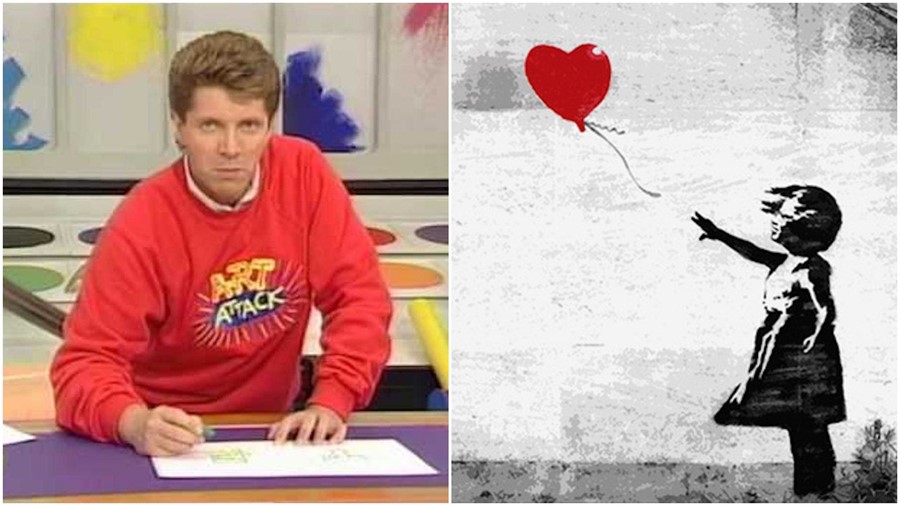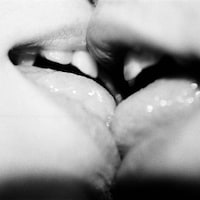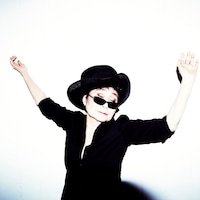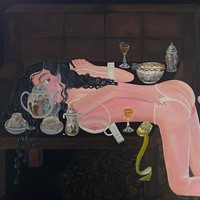The former Art Attack presenter denied that he’s the graffiti artist after a theory went viral – here, artist Paul Gough compares the similarities between the pair’s work
“This is an art attack. This is an art attack. This is…” Banksy? This week, a very convincing theory went viral: that former Art Attack presenter Neil Buchanan is, in fact, the elusive graffiti artist known as Banksy.
The 58-year-old was forced to deny the suggestion after he was “inundated with enquiries” about it. “Neil Buchanan is NOT Banksy,” a statement on the artist’s website reads. “We can confirm that there is no truth in the rumour whatsoever.” Sounds like something Banksy would say IMO.
Instead of painting coronavirus-themed artworks on the tube (à la Banksy), Buchanan reportedly spent lockdown with vulnerable members of his family, and is now preparing to launch his new art collection, which is set to arrive next year.
Interesting…Neil Buchanan WAS known for his big outdoor pieces utilising multimedia props and items to craft uncanny replicas
— The Bonsai Treehouse (@BonsaiTreehouse) September 5, 2020
(and then sometimes getting chased down by a perturbed member of authority who he supposedly “borrowed” the materials from) pic.twitter.com/YiW9BnAL2F
For those who don’t know, Liverpool-born Buchanan rose to fame as the charming presenter of children’s TV show Art Attack, which he hosted from 1990 until 2007. As well as his red Art Attack sweatshirt and catchphrase, “Here’s one I made earlier”, Buchanan was known for his large-scale works (see: the Queen’s head made out of money) and inventive, easy-to-follow creations.
Buchanan was also in a heavy metal band called Marseille, who released four albums, led the new wave of British heavy metal scene, and won the first ever Battle of the Bands in 1977. The band reunited in 2008 and released an album, titled Unfinished Business, in 2010.
Admittedly, this sounds like a lot of work to juggle alongside being an anonymous, world-famous street artist. Nonetheless, how plausible is it that Neil Buchanan could be Banksy?
“Outwardly, there’s not a huge amount that’s similar between Banksy’s work and Neil Buchanan’s,” Paul Gough, vice chancellor at Arts University Bournemouth, artist, and author of Banksy: The Bristol Legacy, tells Dazed. “However, they both use the moving image – short film, explanatory text, compelling storytelling – to share their methods and materials.”
“Outwardly, there’s not a huge amount that’s similar between Banksy’s work and Neil Buchanan’s. However, they both use the moving image – short film, explanatory text, compelling storytelling – to share their methods and materials” – Paul Gough
“Both prefer figuration and representation to express their ideas, and they both have a tendency to rely on the human form to convey the narrative,” adds Gough, before asserting that this is where the similarity ends. “Whereas Buchanan prefers rather coy, poetic, and, at times, maudlin images, Bansky is renowned – indeed revered – for his shrewd, ironic, and acerbic imagery.”
Gough observes that while Buchanan’s work draws on “heart-warming and rather sentimental themes that garner favour with a swathe of the public”, there is “little sentimentality” in Bansky’s stencils, through which “the anger is often palpable”.
Unlike Buchanan, who describes himself as an artist and photographer, and hosted one of the most famous children’s TV shows in the UK, Gough asserts that Banksy “would never call himself an ‘artist’; never appear knowingly on television; prefer not to charge for entry to see an exhibition or installation of his work (except for charity); and likes to kick hard against the establishment, the academies, and the institutions which represent authority and epitomise crass hypocrisy”.
relying heavily on the "Neil Buchanan from Art Attack is Banksy" conspiracy theory to get me through the rest of the year
— Eleanor Margolis (@EleanorMargolis) September 7, 2020
However, Gough does admit that Buchanan’s photographs “show a fine sensitivity of motif”. He adds: “They are deeply tonal, often more experimental in their composition and design, and restricted to black and white, which gives them a moody intensity.” And who else often works in black and white, and is a little bit moody? Banksy.
There’s also the Disney connection. Buchanan “believes Walt Disney was the greatest ideas man that ever lived”; Banksy hates Disney. Sounds at odds, sure, except it isn’t. Buchanan was previously asked to design an attraction for Disneyland Paris, and what did he do (as Banksy, who he is): he created Dismaland.
So, what’s the conclusion? “I don’t think it matters,” says Gough, “we need to ignore the ‘whodunnit’ fixation, look at the work, consider its message, and marvel at the ingenuity and comic timing of an increasingly sophisticated artist-disruptor.”
“We need to ignore the ‘whodunnit’ fixation, look at the work, consider its message, and marvel at the ingenuity and comic timing of an increasingly sophisticated artist-disruptor” – Paul Gough
“For over a decade, people have been speculating about Bansky’s identity, but it has become a distraction from actually looking at the work, or at the causes he’s trying to address,” Gough continues. “Our Western world has become unhealthily obsessed by salacious celebrity stories, by ‘kiss and tell’ confessions, and conspiracy theories. As a result, Bansky has largely been viewed through the lens of ‘whodunnit’.”
“Although he has millions of addicted fans, there are those who feel that Bansky has forsaken street cred for credit in the bank. Yet no one really talks about the art itself; the practice, the innovative visuals, the extensive and challenging graphic language, nor the extraordinary curatorial and filmic skills that make Bansky one of the most diverse popular practitioners of our time.”
“Perhaps that’s where the random connection of Banksy and Buchanan has been made,” concludes Gough. “They both present well to camera, reveal their methods and motives, and create object-based work which is ‘revealed’ on film.”
There you have it folks, Neil Buchanan is, obviously, Bansky.




